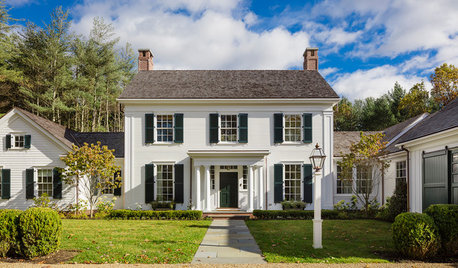October 2019, Week 1
Okiedawn OK Zone 7
4 years ago
Featured Answer
Sort by:Oldest
Comments (31)
Nancy Waggoner
4 years agoRebecca (7a)
4 years agoRelated Discussions
October 2018, Week 1
Comments (35)Moni, I have nights like that a lot, especially if I go to bed early. It is like my body decides it has slept enough and is done with sleep for the night, but my brain always is saying "No.....let me sleep!" I always think I'll make up for the missed sleep by taking an afternoon nap, but then I rarely do. Congrats on demolishing the shed. That's a lot of work! I bet gardening will be more fun with that eyesore of a shed gone. I hope you enjoy your camping in the rain. I like camping in the rain as long as there is a place to retreat to in order to stay warm and dry---even if that place is just a little tent. Larry, It sounds like you have a good solid plan in place. Isn't it amazing what a pain in the neck that tall okra plants can be? I don't want any plant so tall that it makes harvesting difficult. Amy, I am so sorry for the loss of Ron's sister. My deepest sympathy to you all. I hate hearing the news about his other sister's cancer already being end-stage before y'all even found out about it. While I respect a person's right to reveal their own health information as they see fit, I don't understand it when people don't even tell their immediate family members that they have a terminal illness. I totally understand why you wouldn't want to go to NJ given the current state of your mother's health. There are days I don't want to adult either. There's not much new to report here except maybe the snake in my garden. This week I have cautiously entered the garden and done a bit of clean-up work virtually every day. Even if it isn't much work completed in one day, it does add up over the course of a week. I have been careful and watched for snakes. Yesterday I was in the garden only long enough to pull up a few morning glories and moonflower vines sprouting near my tomatoes---mainly because I went out there to check on the tomatoes and then just noticed the vines accidentally. They were trying to climb the tomato plants, so I ruthlessly yanked out every one of them. I still don't know if my fall tomatoes will have time to mature, but the fruit wouldn't stand a chance of doing so if I let the vines climb the plants and cut off their sunlight. So, I never saw or heard a snake while in the garden, but..... While walking down to the mailbox very late in the day, I glanced over at the garden fence as I walked by and there was a shed snake skin woven through the fence about 5' from the entry arbor. I suppose the snake threaded itself through the woven wire fence and rubbed itself against the wire to help remove the skin. I am pretty sure that snake skin wasn't there when I was in the garden because it was right at eye level and there's no way I wouldn't have noticed it. I don't necessarily think it was a venomous snake. Based on the shed snake skin's size, appearance and location, I think it was from a Rough Green Tree Snake because they love to hang out on the coral honeysuckle and cannas there in that immediate area. Still, I'm never happy when snakes send me an "I am here" message in the garden. I think I'll stay out of the garden today. I keep waiting for cooler weather to arrive and make snake activity during the daylight hours more rare, but it just isn't happening yet. Maybe next week. It was a lovely and hot summer day here yesterday, which probably is a gift in October. The girls played in the wading pool for close to 3 hours while I sat in the shade, watching them and supplying an outdoor picnic lunch eaten beside their little wading pool. They'd already had lunch before we went out to the pool, but worked up a big enough appetite to eat a second lunch a couple of hours after the first one. I told Chris when he picked them up in late afternoon that they had an extra lunch in the afternoon and might not be hungry for dinner. It is possible that they crammed in a second lunch in order to avoid dinner because Chris was going to cook a fish "with eyes still on it", in Lillie's words, for dinner and the girls were uneasy about having to eat a fish that looks like a fish. We were joined by lots of butterflies and dragonflies lurking near the water the girls splashed out of the pool. I do not believe I saw or heard a single hummingbird all day. Maybe the last one has headed south. We had a lot of wind yesterday and it kept the mosquitoes off of us for the most part. We'd have a little skeeter trouble when the wind temporarily died down for a few minutes here and there. The mosquitoes? We have the usual ones in great profusion ever since rain started falling in significant amounts again, and 2 or 3 days ago the large gallynippers showed up. Ugh. If it is possible to hate mosquitoes more than I already hated them, then I really, really hate those gallynippers. Dawn...See MoreFebruary 2019, Week 1, Let The Gardening Begin.....
Comments (62)Nancy, I am already beat! Another roughly day and a half of all this activity and I might be dead, but we are having fun. It is good training for the upcoming planting season. Kim, I hope the meeting with the landlady isn't about her having different plans for your house. Enjoy your time with the little man. Jennifer, His name is Frankie and we've been trying for about three years to tame his feral side well enough that we can pick him up, touch him, pet him or exert any sort of control over him. Some feral cats never can acclimate to more domestic behavior, but we are winning him over with canned food. He still looks pretty wild and is incredibly lean and muscular as are many feral to semi-feral cats, but we were able to get him into a crate and take him to be neutered (and to get his shots). He was mad at us yesterday but also at the same time relieved to be back here and no longer at the vet's office, but not so mad he wouldn't let us feed him and pet him. A lot of people say feral cats cannot be tamed, but they can. Sometimes it takes a few years to do it though, and often it is a very slow process where you're forever taking one step forward and two steps back. He and Lucky seem to know each other from their feral journeys. Lucky is fully domesticated now, and I think there is hope for Frankie to someday be as calm and gentle as she is now. Kim, I'm sorry you're ill and hope you recover quickly. Your seeds and planner are a sign, I think, that you'll be gardening somewhere. Bon, The good thing about the cold weather here is that it usually passes through fairly quickly, as least compared to many other states. I hope y'all are toasty warm again soon....without the need for the wood-burning stove to provide that warmth. I think it stays cold here for two more days and the warming trend starts around Monday. If that has changed, I don't want to know it because I'm just hanging on and waiting for the warm weather to come back. Jennifer, Great job, Finbar! He's doing his job as far as he is concerned, and I think dbarron's ID as a shrew is the right one. You have something I've never seen here. I'm not saying we might not have shrews around, just that of all the god-forsaken-wild-things that ours cats and dogs have killed and brought home, there's never been a shrew among them. Nancy, This does feel like a more normal winter although we still haven't been nearly as consistently cold as we were our first few years here. Everything seemed to change around 2005 and since then winters just have gotten warmer and warmer, except for 2010-2011 which was the last really persistently cold winter that I can remember. Rebecca, They really expected more snow and ice flurries in north and central Texas than they received in general, but it isn't because the clouds weren't trying. A lot of snow and ice were falling from the upper levels of the atmosphere but in the very low dewpoints closer to the surface level, the precipitation was evaporating before it could reach the ground. Our dewpoint here was only 12 so I'm not surprised that adjacent areas of north Texas were the same. It was odd to see the Winter Weather Advisory covering the area south of the D-FW metroplex yesterday, but I bet everyone in the DFW area is glad the precip missed them. Nancy, I doubt DFW gets much warmer than we will today, but I think they usually warm up a day earlier than us, so if we are expecting the warmup on Monday, they may get it beginning Sunday. So much flu is running rampant down there now that we are carefully avoiding going south this weekend. Of course, flu is running rampant to our immediate north, so we aren't going far from home at all since Love County seems to have, so far, avoided the widespread flu and strep that now have closed down 8 school districts in the Texoma region. I cannot believe how cold it has been the last couple of days. We are up to 38 degrees and it isn't even noon yet, but I don't think we're expected to get much warmer than what we are right now. The 4 year old is lobbying to go to the playground in Gainesville, but I think it is still too cold for that. Maybe tomorrow will be a touch warmer. Or maybe the sun will come out. Dawn...See MoreJune 2019, Week 1
Comments (28)Nancy, Having cats is about like having small children at times, isn't it? I imagine you blasted all the aphids off before monarchs really have begun much egg laying up there. They're laying eggs down here, but we're always a bit ahead of those of you further north. With QAL and hemlock, the purple streaks on the stem usually are a very obvious indicator. If you look at your plants, you can check the main stalks for very tiny, fine hairs. QAL has those very tiny fine hairs running up and down the stalk, and hemlock's stalks are smooth. My favorite way to tell them apart is that the seed heads of QAL will curl up into a bird nest type shape as the seeds dry. So, if in doubt about any plants that might be QAL or hemlock, just watch the seedheads. We have QAL, but I keep it pulled out of the garden and adjacent areas. I don't mind it elsewhere, just nowhere near where I'm growing anything on purpose because of its invasiveness. This year we have a lot of hedge parsley, especially in the neighbor's pasture due south of us. We've cut it down on our property so it cannot reseed here, but their seeds will wash downhill to us. I don't mind it---it is a host plant for the swallowtails, but at the same time, I don't want it invading my garden and taking over. I'm guessing all the moisture we've had since last Sept. has made every seed that was in the ground germinate and grow. When we moved here we were in our early 40s and this was intended to be our forever home, so I've always had that in mind as I garden---not wanting to create more than we can maintain as we age. Our nearly constant recurring droughts help me a lot in that regard because I cannot create more growing beds than we can irrigate throughout the summer months, and that reins me in more than anything else. We were in the second consecutive year of awful drought and a huge grasshopper infestation when we moved here in 1999, so that helped too---you cannot go crazy creating beds and planting when the ground is rock hard and the grasshoppers are eating every plant in sight down to the ground. You could say that Mother Nature reins me in from going overboard with plantings. Rebecca, That's a lot of rain. We have had less than half than much over the last two weeks. I hope your plants are okay. Larry, It is a hard garden year and the deer are not helping. They keep coming to my garden in broad daylight trying to chase me out of it so they can come in, and they just stand and stare at me like "who do you think you are?" I try to remember to close the garden gate behind me when I go in there so they cannot follow me into the garden. I don't know what their problem is---there's tons of natural food or them. I am pretty sure they want my okra plants, and I don't intend to share them. Jennifer, Sometimes zinnias just do that. I am sure it is some sort of genetic defect or mutation. I don't see it often---just a couple of times ever 4 or 5 years. Echinaceas do it too. What would eat a toad's body? Snakes of many different kinds, hawks or raccoons for sure. Probably other things too. Don't worry. Your kids always will need you, just in a different way. I enjoy the company of our adult son (and nieces and nephews) so much now---it is awesome to see them continue to grow and develop as adults. Then, someday, they'll likely become parents and you and Tom will become grandparents, and that is its own kind of awesome. If the demand for your eggs is higher than your supply, maybe you can refer some of those folks to the Conscious Community Co-op. There's almost always pastured eggs available there. Nancy, It sounds like your water table is coming up pretty high underneath your plants. Hopefully with less rain falling, that water level will begin to fall. I cannot complain about our tomato plants at all. We are reaching the I-cannot-bear-to-eat-another-tomato stage because we've been overdosing on them for 5 weeks now. A lot of my plants look sickly with foliar diseases (not unexpected because I've grown tomatoes in the same soil for 20 years, and they were supposed to be in the back garden this year.....), but they're still producing like crazy. I give the early planting all the credit for this, because I don't think my plants are setting any new fruit now and I don't think anything but the cherry and paste types have set new fruit in the last 2 or 3 weeks. I think the high humidity might be holding them back, because we've only barely been into the 90s at all, and certainly not enough to (theoretically) impede fruit set. I don't even care. Since we've been gorging on all the tomatoes we can eat, if I walked out to the garden tomorrow and all my plants mysteriously had died, I think I'd shrug it off, pull them out and replace them with zinnias and cosmos. Why not? I have 8 beautiful and healthy tomato plants in large containers near the garage that are producing very well if you don't count the minor herbicide drift damage from the neighbor's fence line herbicide spraying. I could be happy with nothing but the fruit from those 8 plants. I'm at the grumpy tomato stage where harvesting them, washing them, sorting them and processing the extras by freezing, drying or canning is annoying me. Life really is a lot easier if you don't grow too many tomatoes. I clearly grow too many, and that is nobody's fault but my own. Every year at this time I swear that I will take off next year from growing tomatoes, but of course, I don't do it. I do wish I had the self-discipline to only plant 6 or 8 tomato plants. My garden is not nearly as weed-free as yours, but I am making good progress. I still have three or four raised beds to weed, and several pathways. I think I have a good chance of getting all that done on Mon-Tues as this is a grandchild weekend and I'm not stepping foot in the garden at all. The tomato-like fruit on the potatoes is the potato fruit (remember, the part we eat is the tuber) which is not edible but contains seeds you can allow to mature on the plant and then sow if you want to try growing potatoes. Some people refer to them as seed balls to make it clear that they are not edible fruit. Google True Potato Seed if you want to read about growing potatoes that way. I did it one year just for fun to see if it could be done (it can!). You won't always get the potato fruit---just like your potatoes do not/will not always flower. I only get potato flowers/fruit in years when the nights stay cool for a prolonged period and those cool nights have to coincide with the potatoes being at about the right stage to flower. I don't have a lot to add about our garden. Although the tomatoes look sickly, I could nip that in the bud if I was willing to spray them with a fungicide, and I don't think I am. Y'all know I hate to spray anything at all on my plants ever. I think I'll just harvest the fruit and yank out the plants one by one whenever I get tired of looking at them. At least the heavy rainfall stopped here a couple of weeks ago, so the tomatoes taste much better now because excessive rainfall is not watering down their flavor. All the beans and tomatoes have spider mites, though not at huge levels yet. Either the predatory mites and lady bugs and other beneficial insects will take care of the spider mites, or they won't. If they do, great, and if they don't, I'll yank out heavily infested plants after the beans are done producing. It is rare for the spider mites to kill tomato plants as the predatory mites usually catch up, population-wise, by July and start knocking back the spider mite population, at which time the tomato plants put on a surge of new growth and rebound. I am concerned about the plethora of grasshopper nymphs I'm seeing and the fact that they are chewing holes in every single leaf on every single plant in my garden. The issue, really, is that our two organic grasshopper bait type control products---Nolo Bait and Semaspore are not available this year, so that is a big problem. I have a bottle of beauveria bassiana and I could use it to control the grasshoppers, but I worry about the effect it would have on other insects inside the garden. I think I'll just try to wait out the grasshopper damage. Or, if I start feeling really desperate about the grasshopper situation, I could spray the beauveria bassiana in a wide band around the outside of the garden fence and hope it kills the grasshoppers as they make their way to the garden. That might be a reasonable compromise. I really don't want to use it inside the garden because it can harm some beneficial insects (not all, but I don't want to sacrifice any of them). Earlier this week I noticed the caterpillar of the Variegated Frittilary Butterfly on my pansy plants. I was getting ready to yank out the pansies and replace them with Profusion zinnias, but now I'll leave the pansies until the Frit caterpillars are done with them. Lillie has been here for a couple of days and nights now and we're about to take her home to spend the rest of the weekend with her family. We tie-dyed 12 t-shirts and 2 pairs of shorts (half for herself, and half for her little sister) so my hands might be looking a little blue, purple and green (and pink, orange and red). lol. I've scrubbed them pretty hard and think most of the dye is gone now. I did wear gloves while tying and dying, but not when I was taking the rubber bands off the t-shirts to rinse them before running them through the washing machine. That is what gets me every time. Now that I've washed the t-shirts and shorts twice in the washing machine with those SHOUT dye-catcher things in there with them, I think they won't fade in a normal laundering, but I'll send the rest of the box of dye-catchers home with her today so they can protect the next few loads of laundry they wash. That worked out well for all of us last year, and now that we have tie-dyed t-shirts for 2 consecutive summers, Lillie has declared it to be "our family tradition". I'm okay with that. Hope everyone is having a good weekend. It is 88 degrees here and starting to feel a little bit toasty. Dawn...See MoreJuly 2019, Week 1
Comments (30)I'm still catching up. Nancy, I usually don't see aphids at all, though I saw them on western ironweed growing outside the garden fence this year. Ants were farming them and lady bugs were trying to eat them, so the ants and ladybugs were slugging it out. This year the oleander aphids did pop up on my butterflyweed plants in the garden, but about 2 minutes after I noticed them there, I saw ladybugs working the plants. A day or two later, all the oleander aphids were gone. It just amazes me how good the ladybugs are at finding a 'problem' and dealing with it or, from their point of view, maybe they are just happy to have a nice meal. When I was younger, more foolish and inclined to ignore the heat, I would just garden hard, endlessly, throughout July and August. Now? Being older and wiser, I listen to the heat and listen to my body and know when enough is enough....and I try to get out of the heat before 'enough' becomes 'too much'. I'm already looking at the tomato plants in the big containers and asking myself if I want to water them all summer long. Y'all shouldn't be surprised if I stop watering them in 2, 3 or 4 weeks. I don't even have the patience any more to stand out there in the heat with a hose in my hand....so heaven help those plants when I start thinking it is too hot at 7 a.m. (Or, I could just put up the drip irrigation lines for them.) The last few years, I've turned my focus to indoors DIY projects and this year might be kinda sorta the same, more or less, at least in August.and comes into bloom and produces much faster than okra planted in cool weather despite the estimated DTMs. I planted Jambalaya (which has a quick DTM of 50 days anyway) in, hmmm, late May I think, and it was producing by the end of June. I think it was so fast because it didn't really experience cool soil temperatures. Hopefully your okra will produce extra-quickly like that. You know, I learned this with hot peppers ages ago. I used to put them in the ground the same time I plant tomatoes, but that exposed them to soil temperatures and sometimes nighttime lows that are cooler than they like and it slows them down. Nowadays I plant them 2-4 weeks later than the tomato plants, and am harvesting hot peppers in June regardless---and heavier yields than I got from those earlier plantings. It amazes me what a difference it makes when the plants are not exposed to any cold. Benadryl for pets is important at times though it depends on the bite's locatio. We have had neighbors' dogs get bitten on the paw and the paw swelled so quickly that it halted the flow of blood and they lost the dog, so we always give a dog Benadryl if it is bitten and we usually don't even go to the vet. You can see the dogs' swelling go down literally in front of your eyes. I don't know why it doesn't work for people, but I know it is absolutely not recommended for people. Here's my theory though: If you've ever known anyone who was bitten by a venomous snake, you might have noticed the doctors circle the wound area and mark on it with a Sharpie. They come back, usually every 30 minutes, and mark the extent of the swelling or redness and this allows them to track the way the person's reaction is advancing (or, eventually) receding, in the area of the bite. This is important info for them as it can guide some treatment choices. So, if you have taken something like Benadryl and if it affects you by decreasing the swelling, it can interfere with their ability to track your reaction. I think medical personnel are the ones to decide if you are having an allergic reaction (which is separate from your body's reaction to the venom) and if you need an antihistamine, which one, etc. Jennifer, Yes, grocery story squash normally will be hybrid. They have special hybrids bred for commercial growers and I'd be surprised if you could buy any grocery store squash that is not a hybrid. Yes, your mystery squash could very well be one of mini pumpkins grown as decorative items. Amy, Yes, I wish we had that cool Spring weather back again. Sadly, we do not. Nancy, After worrying that Chris will accidentally blow up himself and kill himself setting off fire works, I'm over it. I spent over 2 hours this afternoon opening up all the packaging, taking things out, etc. and lining them up on a shelving unit so they are ready to go. I had a big black trash bag completely full of all the external wrappers and the bags from the Fireworks stand. The fireworks don't have to kill him. I am going to kill him myself. He bought enough fireworks to open his own fireworks stand, and I am not kidding about that. He bought a bunch of these big boxes with a fuse. You light the fuse, and the box goes off---some of them have 20 to 250 shells or balls in them that will go off in rapid succession. Our neighbors, and all the animals, are going to hate us tonight. I bet he has 20 or 30 of those, big box things, and they are just the tip of the iceberg. In his defense, the smaller stuff he bought earlier in the week is much smaller and run-of-the-mill. It is today's purchases, on half-off-everything day at the fireworks warehouse that enabled him to buy too much of everything and most of it really big stuff. I'm glad Tom, and you, survived his night out. I hate being outside listening to all the fireworks and will be glad when this weekend is over. K, I'm out of time, but almost caught up. Time for me to get dinner on the table. There will be six of us for dinner: 4 adults and 2 wrinkled prunes who don't even care that much about the fireworks because, for them, it is all about the pool. Have a nice evening everyone. I believe I am going to have a loud one. Dawn...See Moreslowpoke_gardener
4 years agodbarron
4 years agoOkiedawn OK Zone 7
4 years agoAmyinOwasso/zone 6b
4 years agoNancy RW (zone 7)
4 years agohazelinok
4 years agolast modified: 4 years agojlhart76
4 years agoOkiedawn OK Zone 7
4 years agoOkiedawn OK Zone 7
4 years agoNancy Waggoner
4 years agohazelinok
4 years agolast modified: 4 years agoslowpoke_gardener
4 years agohazelinok
4 years agoOkiedawn OK Zone 7
4 years agoOkiedawn OK Zone 7
4 years agohazelinok
4 years agoslowpoke_gardener
4 years agodbarron
4 years agolast modified: 4 years agohazelinok
4 years agoOkiedawn OK Zone 7
4 years agodbarron
4 years agoOkiedawn OK Zone 7
4 years agodbarron
4 years agoNancy RW (zone 7)
4 years agolast modified: 4 years agoRebecca (7a)
4 years agoNancy RW (zone 7)
4 years agoOkiedawn OK Zone 7
4 years agodbarron
4 years ago
Related Stories

TRENDING NOWThe 5 Most Popular Kitchens of the Week of 2019
Two-tone cabinetry, custom range hoods and clever storage were among the standout features in these much-loved kitchens
Full Story
TRENDING NOWThe Most Popular Bathroom of the Week Stories of 2019
Bright, spa-like bathrooms that put their unique layouts to good use wowed the Houzz community most this year
Full Story
EVENTS5 Big Trends From This Week’s High Point Market
Learn the colors, textures and shapes that are creating a buzz in interior design at the market right now
Full Story
LATEST NEWS FOR PROFESSIONALS6 Takeaways From the Remodeling Industry in Early 2019
The Q1 Houzz Renovation Barometer reveals mixed expectations by U.S. firms for their business activity this quarter
Full Story0

TRENDING NOWReaders’ Favorite Patio Renovation Stories of 2019
Outdoor living rooms, fire features and terraces feature in the most popular Patios of the Week
Full Story
KITCHEN DESIGNNew This Week: 3 Beautifully Balanced White Kitchens
See how designers use cabinet hardware, wood and other accents to bring layers of interest to mostly white kitchens
Full Story
TRENDING NOWThe Top 10 Laundry Rooms of 2019
Green-blue cabinets, cement floor tiles and open shelving are among the most popular features of laundry rooms this year
Full Story
EVENTS5 Design Trends at Fall's High Point Furniture Market 2019
Bold colors and prints, light wood finishes and cozy textiles made a splash at the North Carolina furniture trade show
Full Story
INSIDE HOUZZHow Long It Took to Plan and Complete a Remodel in 2019
Kitchens took the longest of any room to plan and renovate, the 2020 U.S. Houzz & Home survey reveals
Full Story
TRENDING NOWDive Into the 10 Most Popular Pools of 2019
Simple rectangular pools, local materials and well-designed pool houses ruled the most popular images this year
Full Story




dbarron